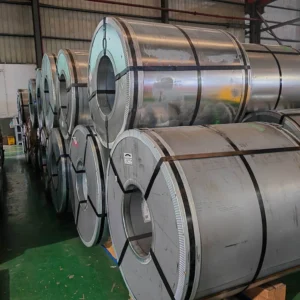Introduction
As industries worldwide shift toward smarter energy use and higher efficiency, cold rolled electrical steel has become a critical material in the manufacturing of modern electrical components. Its unique magnetic and mechanical properties make it essential for power transformers, electric motors, and a wide range of energy-efficient devices.
This article explores what cold rolled electrical steel is, how it is made, and why it is so important for industries in Europe and the Middle East. It also highlights key applications, emerging trends, and how manufacturers are innovating to meet global demands.
What Is Cold Rolled Electrical Steel?
Cold rolled electrical steel, also known as silicon steel or lamination steel, is a specialized steel product made for use in electromagnetic applications. It is processed through a cold rolling method, where steel is rolled at room temperature to achieve precise thickness and surface characteristics.
This steel is typically alloyed with a small amount of silicon (up to 3.5%) to improve its electrical resistance and magnetic performance. The cold rolling process enhances its mechanical properties, surface finish, and magnetic efficiency.
There are two primary types:
- Grain-Oriented Electrical Steel (GOES): Ideal for transformers due to its directional magnetic properties.
- Non-Grain-Oriented Electrical Steel (NGOES): Used in rotating machines such as motors and generators because of its isotropic magnetic behavior.
Why Is Cold Rolled Electrical Steel Important?
Electrical steel is used in the cores of transformers, motors, and other electromagnetic devices to guide and strengthen magnetic fields. Cold rolled electrical steel minimizes energy loss, known as core loss, which includes hysteresis and eddy current losses.
This improved efficiency leads to:
- Lower energy consumption
- Reduced operational costs
- Smaller and lighter component design
- Lower carbon emissions
For industries in Europe and the Middle East, where energy efficiency and environmental regulations are strict and becoming more stringent, using high-performance cold rolled electrical steel is essential.
The Manufacturing Process
The production of cold rolled electrical steel involves several steps, each contributing to its magnetic, mechanical, and surface properties:
- Hot Rolling and Pickling: Steel slabs are hot-rolled and cleaned with acid to remove scale.
- Cold Rolling: The steel is rolled at room temperature to achieve the desired thickness and surface finish.
- Annealing: Heat treatment aligns the grain structure to improve magnetic properties.
- Decarburization: Removes excess carbon to minimize core loss and magnetostriction.
- Coating: An insulating coating is applied to the surface to reduce eddy currents and improve corrosion resistance.
- Slitting or Shearing: The steel is cut into final shapes depending on the application (motor cores, transformer laminations, etc.).
Quality control throughout the process ensures that the final product meets specific standards for magnetic loss, thickness tolerance, insulation resistance, and flatness.
Key Properties of Cold Rolled Electrical Steel
- Low Core Loss: Reduces the amount of energy converted to heat, improving overall efficiency.
- High Permeability: Allows magnetic flux to pass easily through the steel, reducing energy consumption.
- Excellent Insulating Coating: Minimizes eddy currents between laminations.
- High Strength and Ductility: Ensures mechanical durability under high rotational speeds.
- Uniform Thickness and Surface Quality: Crucial for consistent stacking and magnetic performance.
These features make cold rolled electrical steel the material of choice for modern, high-efficiency electrical equipment.
Applications Across Key Industries
1. Power Generation and Distribution
In Europe and the Middle East, cold rolled electrical steel is widely used in transformers that distribute energy across national grids and renewable energy installations. The use of GOES ensures low energy loss during long-distance power transmission.
2. Automotive and Electric Vehicles
With the rise of electric vehicles (EVs), demand for efficient, compact, and lightweight motors is increasing. NGOES is ideal for high-speed rotors in EVs, where magnetic losses must be minimized to extend battery range.
3. Industrial Motors and Machinery
Industrial motors account for a large portion of global electricity use. Using high-grade cold rolled electrical steel can significantly reduce energy use in factories, refineries, HVAC systems, and more.
4. Renewable Energy
Wind turbines, hydroelectric generators, and solar inverters rely on cold rolled electrical steel to optimize magnetic performance and reliability under varying loads and environmental conditions.
5. Consumer Electronics and Appliances
Motors in refrigerators, washing machines, and air conditioners benefit from the energy-saving properties of cold rolled electrical steel, meeting energy labeling standards in EU and Middle East markets.
Trends in Europe and the Middle East
In Europe, the EU’s Green Deal, Ecodesign Directives, and push for decarbonization are driving the demand for efficient electrical products. Cold rolled electrical steel plays a central role in supporting energy-efficiency targets.
In the Middle East, countries such as Saudi Arabia, the UAE, and Egypt are investing heavily in modernizing their power infrastructure, renewable energy projects, and electrified transportation systems. Cold rolled electrical steel helps ensure these systems operate at peak performance with minimal energy waste.
Innovation and Sustainability
Manufacturers are innovating to meet the evolving needs of global markets:
- Ultra-Thin Grades: As frequency in electrical devices increases, thinner laminations are needed to reduce losses.
- Laser Scribing: Improves magnetic domain alignment in GOES for reduced core loss.
- Eco-Friendly Coatings: New coatings are less harmful to the environment and offer better electrical resistance.
- High-Frequency Steel: Used in compact, high-speed motors for robotics and aerospace.
Sustainability is also a key benefit—cold rolled electrical steel is recyclable and can help reduce the carbon footprint of various industries.
Challenges and Outlook
While demand is growing, there are challenges such as raw material availability, trade policies, and the need for continuous technological upgrades. However, investment in R&D, advanced rolling mills, and automation is helping suppliers stay competitive.
The future outlook is promising, with growth driven by:
- Electrification of transport
- Smart grid expansion
- Renewable energy adoption
- Energy-efficiency regulations
Companies that can deliver consistent, high-quality cold rolled electrical steel will be well-positioned in both developed and emerging markets.
Conclusion
Cold rolled electrical steel is more than just a material—it’s a backbone of efficient, sustainable power systems. Its magnetic performance, low energy loss, and adaptability across sectors make it essential for modern energy infrastructure.
Whether for transformers in the European Union or high-speed motors in the Middle East, cold rolled electrical steel will continue to shape the way we generate, use, and conserve energy. For companies and engineers aiming for excellence in performance and sustainability, it remains a critical component of future-forward design.




